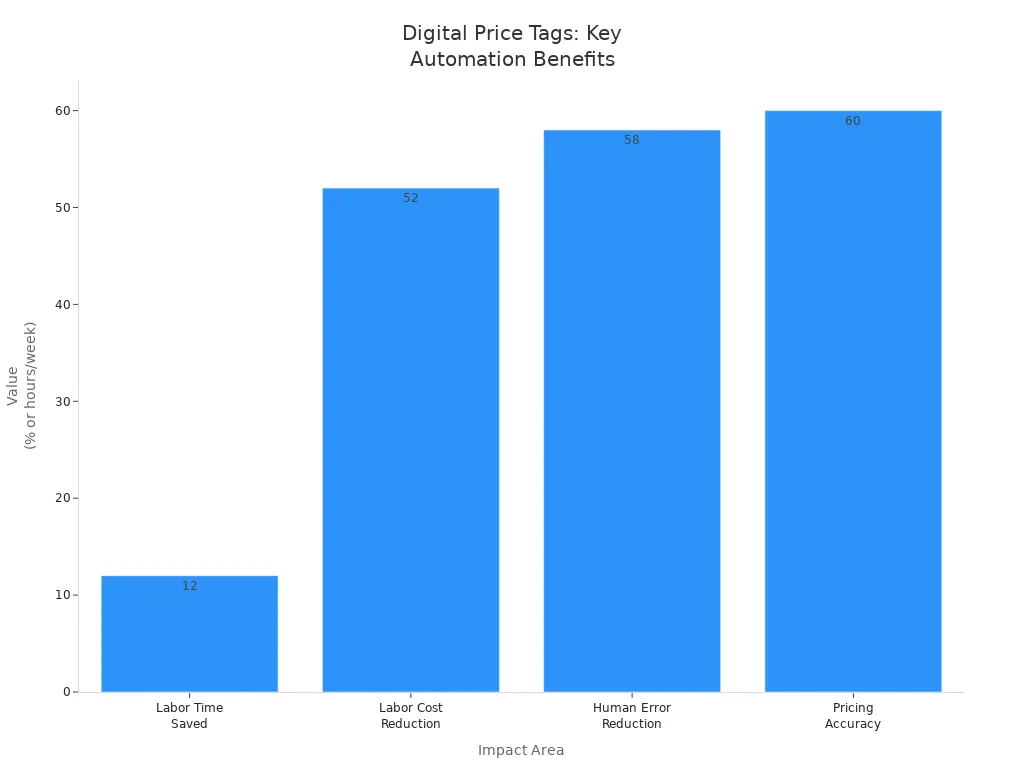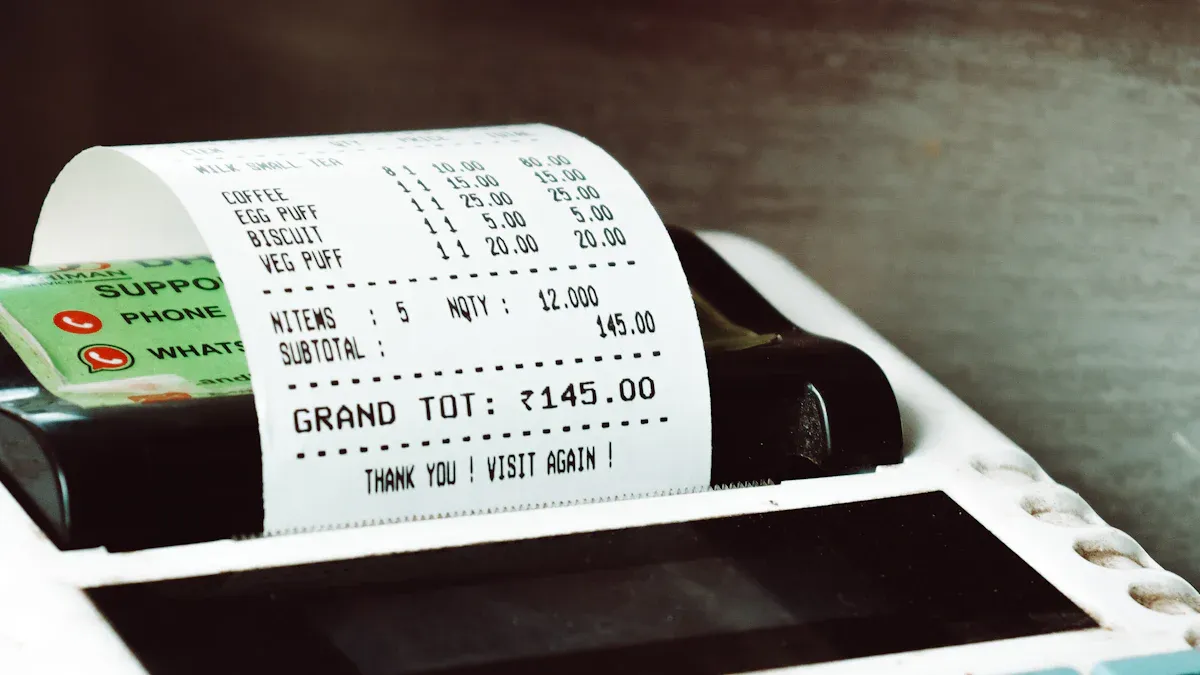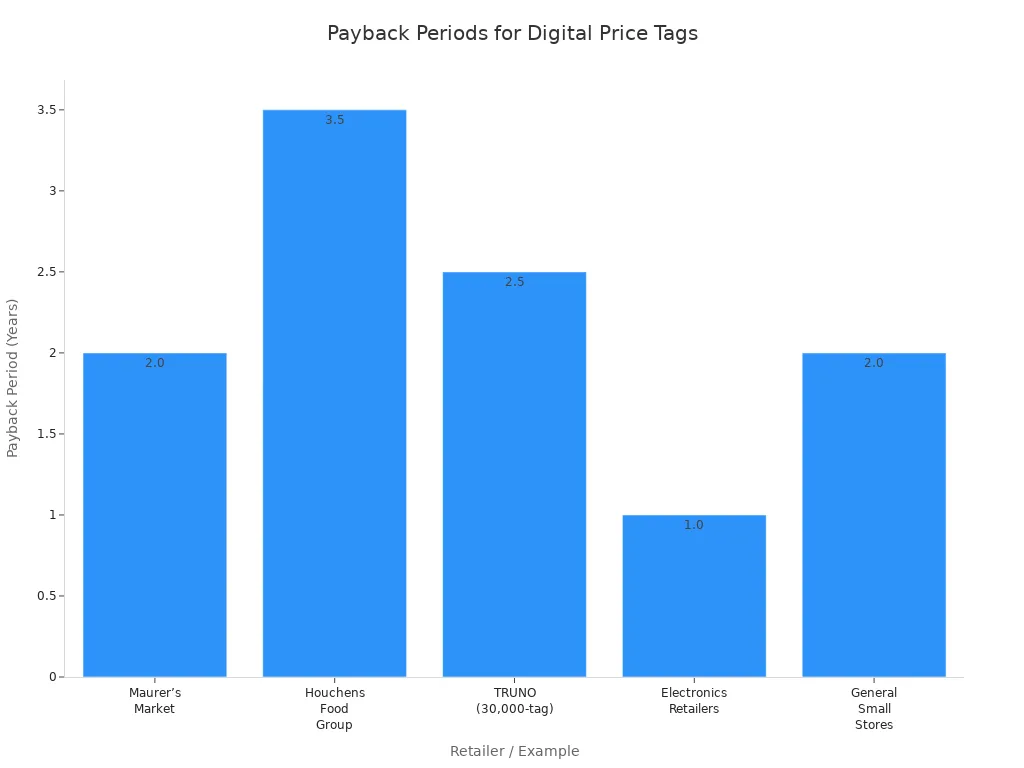
Digital price tags transform your retail operations by automating price changes and eliminating manual labor, helping you reduce cost and improve efficiency. With Electronic Shelf Labels and ESL Price Tag systems, you synchronize shelf and checkout prices in real time, minimizing pricing errors and enhancing the customer experience.
- Digital price tags like Esl Retail and ESL Gateway AP connect directly to your POS, enabling real-time updates and dynamic pricing.
- You improve pricing accuracy, cutting costs related to labor and materials, which helps reduce overall operational expenses.
- Staff spend less time on manual updates and more time assisting shoppers, boosting efficiency and customer satisfaction.
By integrating Electronic Shelf Labels and ESL Gateway AP, you create a responsive, agile store environment that delivers transparent pricing and measurable cost savings.
What Are Digital Price Tags and How Do They Reduce Cost?

Digital price tags have become essential tools for modern retailers who want to cut expenses and improve efficiency. When you transition to digital shelf labels, you gain the ability to update prices instantly across your entire store network. This technology not only streamlines your operations but also delivers measurable cost savings.
How Digital Price Tags Work
Wireless Communication and Centralized Control
Digital shelf labels use wireless communication to connect with a central management system. You can control every price on your shelves from one dashboard. This centralized approach eliminates the need for manual updates, which often lead to errors and wasted labor. With digital price tags, you can:
- Update thousands of prices in seconds, even across multiple locations.
- Ensure every shelf matches the checkout system, reducing pricing disputes.
- Respond quickly to market changes or promotions.
Tip: Centralized control means you never have to worry about inconsistent pricing between stores or departments.
Integration with POS and Inventory Systems
Digital shelf labels integrate seamlessly with your POS and inventory systems. This integration allows you to automate price changes based on stock levels, promotions, or competitor activity. You can also use data analytics to optimize your pricing strategies and improve profitability.
Here’s a look at the impact of automation in retail environments:
| Impact Area | Evidence Detail |
|---|---|
| Labor Time Saved | Up to 12 hours saved per week per store by automating price updates |
| Labor Cost Reduction | Approximately 52% reduction in labor costs related to price updates |
| Human Error Reduction | 58% reduction in human error in pricing and inventory marking due to automation |
| Pricing Accuracy | 60% increase in pricing accuracy after adopting digital price tags |
| Staff Redeployment | Employees freed from manual pricing tasks to focus on customer service |

Types of Digital Price Tags
Electronic Shelf Labels (ESLs)
Electronic shelf labels represent the most common type of digital shelf labels in retail. You will find that ESLs typically use e-ink or LCD/LED technology. E-ink displays offer limited colors and consume very little power, so their batteries can last several years. These digital shelf labels display price, product details, and promotional information. Smaller e-ink tags cost around $5 to $6, while larger, more advanced tags can reach up to $20 or more. Retailers often choose e-ink ESLs for their cost-effectiveness and long battery life.
Interactive and Smart Labels
Some digital shelf labels go beyond basic pricing. Interactive and smart labels use LED or LCD screens to show full-color images, customer reviews, or advertisements. These digital price tags support dynamic content and can engage shoppers with real-time information. However, they come at a higher price and require more power. You might select these labels for high-impact displays or premium product areas where visual appeal matters most.
- Instant price updates from a central system reduce manual labor and pricing errors, saving up to 50% on label management costs.
- Elimination of expenses related to traditional paper labels such as printing, distribution, and labor.
- Ultra-low power consumption and long battery life reduce operational costs.
- Use of reusable materials decreases material costs and environmental impact.
- Centralized control and data analytics optimize resource use and enable dynamic pricing strategies, improving profitability and operational efficiency.
- Enhanced accuracy and shelf efficiency reduce waste and improve customer satisfaction.
By adopting digital shelf labels, you position your store for greater efficiency, lower costs, and improved customer trust. The transition to digital shelf labels supports your goals for operational excellence and sustainable growth.
Reduce Cost by Automating Price Updates
Automated pricing solutions like digital price tags transform your store’s approach to price management. You no longer need to rely on manual processes that drain resources and introduce errors. By shifting to a reliable price automation system, you reduce cost, improve efficiency, and create a more agile retail environment.
Labor Cost Reduction
Eliminating Manual Price Changes
Manual price changes consume significant labor and time. Traditional methods often require staff to print, cut, and replace paper labels throughout the store. This process can take hours or even days, especially during large-scale promotions or seasonal changes. Digital price tags automate these tasks, allowing you to update thousands of prices in minutes from a central dashboard.
With digital price tags, you can reprice your entire store network almost instantly, reducing labor hours by up to 90%. For example, Naifeh’s Cash Saver saved 50 labor hours weekly after switching to digital price tags, cutting the time for price changes from two days to just minutes.
You eliminate the need for manual printing and placement, which directly reduces labor costs. Staff no longer spend valuable time on repetitive tasks, and you avoid the hidden costs associated with overtime or temporary labor during peak periods.
Freeing Staff for Customer Service
When you automate price updates, your team can focus on higher-value activities. Employees who once spent hours updating labels now have more time to assist customers, manage inventory, and maintain store appearance. This shift not only improves operational efficiency but also boosts employee morale.
| Aspect | Impact |
|---|---|
| Labor Savings | 50 labor hours saved weekly; price changes now take minutes instead of days |
| Productivity Improvement | Staff can focus on customer service and inventory management |
| Operational Efficiency | Automation ensures real-time price updates and integrates inventory alerts for faster restocking |
Digital price tags help you allocate your workforce more effectively. You address labor shortages and enhance the customer experience by having more staff available on the sales floor.
Minimizing Human Error
Consistent and Accurate Pricing
Manual price updates often lead to pricing errors. Staff may miss labels, enter incorrect prices, or fail to synchronize shelf and checkout prices. Digital price tags eliminate these risks by synchronizing in real time with your point-of-sale system. Every price change is logged, ensuring transparency and accountability.
Digital price tags have demonstrated a 58% decrease in pricing and inventory marking mistakes and a 60% improvement in pricing accuracy. You maintain consistent pricing across all locations, which builds customer trust and reduces operational headaches.
Fewer Customer Complaints and Disputes
Accurate, automated price updates lead to fewer customer complaints and disputes at checkout. When shelf prices always match the register, customers feel confident in your store’s integrity. Retailers using digital price tags report faster price updates and a noticeable reduction in pricing disputes.
Customers trust the accuracy of digital price tags, which results in smoother checkout experiences and higher satisfaction. You spend less time resolving disputes and more time delivering value to your shoppers.
By minimizing pricing errors and ensuring reliable, up-to-date information, you reduce cost associated with lost sales, returns, and negative customer interactions. Digital price tags support your goal of operational excellence and help you maintain a competitive edge in today’s fast-paced retail landscape.
Reduce Cost on Materials and Printing

Switching to digital price tags allows you to eliminate recurring expenses on paper, ink, and printer maintenance. Traditional price tags require constant printing and replacement, which leads to high material costs and ongoing operational headaches. When you adopt digital shelf labels, you move to a cost-effective label update system that removes these expenses entirely.
Eliminating Paper and Ink Expenses
You no longer need to purchase paper, ink, or printers when you use digital price tags. Retailers typically save thousands of dollars each year by removing these recurring costs. Digital shelf labels enable real-time price updates without the need for physical replacements, which means you avoid printing thousands of tags every week. This shift not only reduces cost but also streamlines your operations.
Environmental Impact of Reduced Waste
Digital price tags help you meet sustainability goals by cutting down on paper and ink waste. ePaper signage supports global standards like WEEE and ISO 14001 by lowering energy use and minimizing single-use materials. You reduce landfill waste because digital shelf labels last up to ten years, compared to frequent disposal of paper tags. The energy-efficient technology in digital price tags consumes power only during updates, further reducing your carbon footprint. Many digital labels use recyclable or biodegradable components, supporting responsible disposal and a circular economy.
By adopting digital shelf labels, you show your commitment to eco-friendly practices and appeal to environmentally conscious shoppers.
Ongoing Savings Over Time
The savings from digital price tags continue year after year. You eliminate the need for constant supply purchases, replacing them with a one-time investment in digital shelf labels. These labels require minimal maintenance and have a long lifespan, often lasting five to ten years on a single battery. You also reduce labor costs related to manual price updates by up to 80%. Integration with your store management systems allows for real-time updates, which further reduces downtime and operational disruptions.
Streamlined Label Management
Managing price tags becomes much simpler with digital shelf labels. You can update prices across your entire store network from a central dashboard, which saves time and reduces errors.
Centralized Updates vs. Individual Replacements
The difference between digital price tags and traditional methods is clear:
| Aspect | Digital Price Tags (ESLs) Impact | Traditional Price Tags Impact |
|---|---|---|
| Labor for price updates | Up to 80% reduction in manual labor | High manual labor required |
| Workload reduction | 60% reduction in tasks like price updates and shelf management | Higher workload due to manual updates |
| Price synchronization speed | 40% faster synchronization of prices | Slower, manual synchronization |
| Error rate | Nearly eliminates manual errors | Manual errors common |
| Price change implementation | Reduced from hours to seconds | Hours required for manual changes |
You gain the ability to synchronize prices instantly, which minimizes compliance risks and labor expenses.
Less Storage and Supply Management
Digital shelf labels reduce the need for storage space dedicated to paper, ink, and replacement tags. You no longer need to manage large inventories of supplies or worry about running out during busy periods. This streamlined approach frees up valuable backroom space and simplifies your supply chain.
Digital price tags offer a smarter, more sustainable way to manage your store’s pricing, helping you reduce cost and improve operational efficiency.
Operational Efficiency and Real-Time Price Updates
Digital price tags drive operational efficiency by enabling you to manage prices with speed and precision. You gain the power to update prices instantly across all your locations, ensuring consistency and reducing manual workload. This section explores how real-time price updates and error-free pricing compliance transform your retail operations.
Instant Price Adjustments Across Locations
Responding to Market Changes Quickly
You can react to market shifts in minutes, not days. Digital price tags let you adjust prices based on demand, inventory, or competitor actions. This flexibility means you never miss an opportunity to optimize sales or clear stock.
- Real-time price changes reflect market conditions and consumer preferences.
- Quick markdowns for perishable items help reduce waste and maximize profit.
- Departments like deli and meat benefit from dynamic pricing, responding to inventory status and seasonal trends.
- Instant price updates across multiple locations save significant labor and time.
- You eliminate manual errors and ensure customers always see the correct price.
“Before digital shelf labels, changing prices in a store took a couple of days; now it takes only minutes. Price updates are sent by the merchant team and can be quickly applied using a mobile device, keeping shelf prices and promotions always up to date. This fast and automatic price management allows staff to focus more on customer service and improves accuracy and speed in order preparation and stocking.”
Retailers use digital price tags to adjust prices almost instantaneously in response to signals like slowing sales or store crowding. Automated processes require minimal human intervention, letting you react immediately to competitor price changes and capture more profit or market share.
Dynamic Pricing Opportunities
Digital price tags open the door to real-time pricing strategies. You can:
1. Instantly and remotely update prices based on demand, supply, inventory levels, and competitor pricing. 2. Reduce excess inventory and align prices with consumer needs, especially for perishable or seasonal goods. 3. Execute price changes within seconds or minutes, enhancing pricing flexibility. 4. Apply automated price adjustments during sales or clearance events across all stores at once. 5. Maximize profits by continuously adapting prices to external factors such as competition, weather, and festivals.
You streamline price changes across all inventory with just a few clicks, avoiding labor-intensive manual updates. This approach reduces pricing errors, ensures customers see accurate prices, and enhances trust. Integration with inventory management systems keeps your pricing data synchronized in real time.
Error-Free Pricing and Compliance
Synchronization with Promotions and Sales
Digital price tags ensure your promotions and sales are always up to date. You synchronize prices across all channels, preventing discrepancies between shelf and checkout. This accuracy builds customer trust and reduces disputes.
| Benefit Category | Description | Example / Impact |
|---|---|---|
| Minimizing Human Error | Automated and consistent pricing updates reduce manual mistakes and pricing discrepancies. | A European supermarket chain reported a 40% reduction in pricing errors after adoption. |
| Compliance with Pricing Rules | Instant, error-free price updates help meet regulatory requirements and avoid fines. | Supports consumer protection laws and pricing regulations compliance. |
| Operational Efficiency | Automation reduces manual labor, allowing staff to focus on customer service and inventory tasks. | Retailers like Lee’s Discount Liquor and POCO improved efficiency by shifting staff focus. |
| Pricing Consistency | Synchronization across inventory prevents pricing discrepancies and customer frustration. | Maintains accurate prices at checkout, building trust with customers and regulators. |
Compliance with Pricing Regulations
You meet pricing regulations with ease when you use digital price tags. Real-time price updates through wireless connections ensure prices are accurate and comply with local laws. Centralized control lets you enforce pricing rules across all locations. Audit trails and reporting features track every price change, supporting transparency and compliance.
- Digital price tags improve price verification and accuracy, reducing errors from manual labeling.
- You prevent pricing discrepancies between shelf and point of sale.
- The technology allows you to display appropriate sales and marketing visuals, ensuring compliance with local regulations.
Digital price tags help you maintain operational efficiency, reduce errors, and build trust with both customers and regulators.
Enhanced Pricing Strategies to Reduce Cost and Boost Competitiveness
Dynamic and Personalized Pricing
Adapting to Competitor Moves Instantly
You can use digital price tags to respond to competitor pricing in real time. These systems connect to your central management platform, allowing you to adjust prices across all locations instantly. When a competitor lowers their price, you can match or beat it within minutes. This agility helps you maintain your market position and attract more customers.
- Digital price tags enable instant price updates, eliminating manual errors.
- You can automate markdowns based on inventory levels, such as discounting overstocked items.
- Dynamic pricing strategies include time-based, demand-driven, and competitor-based pricing.
- Retailers like Amazon and Walmart update prices millions of times daily, showing the scalability and responsiveness of digital solutions.
- McKinsey reports that effective dynamic pricing can increase retailer revenue by 5–15%.
With digital price tags, you gain the flexibility to implement advanced pricing strategies that keep you ahead of the competition.
Targeted Promotions and Flash Sales
Digital price tags allow you to launch targeted promotions and flash sales with ease. You can personalize offers based on customer behavior, shopping history, or loyalty status. Integration with mobile apps lets you push special deals directly to shoppers in-store, increasing engagement and driving sales.
Tip: Use digital price tags to highlight limited-time offers or exclusive discounts. This approach creates urgency and encourages immediate purchases.
You can also automate price changes for specific products or categories, ensuring that your promotions reach the right audience at the right time. This level of personalization boosts customer satisfaction and loyalty.
Data-Driven Decision Making
Analyzing Pricing Performance
Digital price tags provide you with accurate and timely data on pricing performance. By integrating with your ERP and analytics platforms, you can track which price points drive the most sales and identify trends across locations. AI-driven forecasting uses machine learning to analyze demand factors, such as promotions and supply constraints, resulting in more precise pricing decisions.
- Unified platforms integrate data across departments, enabling responsive adjustments to price elasticity and demand shifts.
- AI-powered planning minimizes waste and improves accuracy in pricing and inventory decisions.
- Case studies show improved profitability and operational efficiency through data-driven pricing strategies.
You can use these insights to refine your pricing approach and maximize revenue.
Optimizing Margins and Inventory
With digital price tags, you optimize both margins and inventory. Automated replenishment systems use demand forecasts to maintain ideal stock levels, reducing waste and improving on-shelf availability. Storage and space optimization tools help you avoid overstocking and bottlenecks by aligning inventory with actual store needs.
| Benefit | Impact |
|---|---|
| Inventory Optimization | Reduces waste and improves product availability |
| Margin Improvement | Enables precise price adjustments for higher profit |
| Scalability | Supports quick adaptation to market changes |
Digital price tags support future-proof scalability and configurability. You maintain control over pricing and inventory processes, ensuring your business adapts quickly to changing market conditions while maintaining efficiency.
Additional Benefits Beyond Cost Reduction
Improved Customer Experience
Clear, Consistent, and Up-to-Date Pricing
You deliver a better shopping experience when you use digital price tags. Customers always see accurate and current price information on the shelf. Real-time updates ensure that the price displayed matches the checkout, which builds trust and reduces confusion. Digital price tags also display detailed product information, such as nutritional facts, allergen warnings, and stock availability. This transparency helps shoppers make informed decisions and increases their confidence in your store.
- Customers benefit from real-time price updates.
- Product details and reviews are available at a glance.
- Inventory integration shows product availability and restock times.
Faster Checkout and Fewer Disputes
Digital price tags help you speed up the checkout process. When you connect these tags to your POS system, you reduce the risk of price discrepancies at the register. This leads to fewer disputes and a smoother transaction for both staff and customers. Some systems use RFID or NFC technology to further accelerate scanning, which shortens wait times and improves satisfaction. By automating price updates, you allow your staff to focus on customer service rather than resolving pricing issues.
Tip: Accurate pricing and faster checkout create a positive impression and encourage repeat visits.
Sustainability and Brand Image
Eco-Friendly Operations
You support sustainability goals by switching to digital price tags. These systems eliminate the need for paper, ink, and frequent replacements. Long-lasting digital shelf labels reduce waste and energy consumption. Many retailers choose digital solutions to align with eco-friendly practices and demonstrate responsibility to their customers.
Meeting Consumer Expectations
Modern shoppers expect transparency and responsible business practices. Digital price tags help you meet these expectations by providing up-to-date information and supporting green initiatives. When you display accurate price and inventory data, you show your commitment to honesty and customer care. This approach strengthens your brand image and builds loyalty.
Marketing and In-Store Engagement
Digital Promotions and QR Codes
Digital price tags open new opportunities for marketing and enhanced customer engagement. You can display targeted promotions based on shopper behavior or preferences. Personalized offers increase satisfaction and drive sales. Many digital tags include QR codes that link to additional product information, reviews, or even videos. Shoppers scan these codes to access more details, bridging the gap between online and in-store experiences.
- Targeted promotions and flash sales boost interest.
- QR codes provide instant access to rich product content.
- Digital interaction encourages customers to explore and engage with your brand.
Interactive Product Information
You can use digital price tags to deliver interactive content right at the shelf. Customers tap or scan to see product comparisons, availability, or even add items to a digital basket. This seamless integration of digital and physical shopping creates a unified experience. Retailers who adopt these features often see improved employee productivity and higher customer satisfaction.
Note: Interactive digital features help you stand out in a competitive market and support a strong omnichannel strategy.
Investment, Implementation, and ROI
Upfront Costs and Budget Considerations
Hardware, Software, and Installation
When you plan to implement digital price tags, you need to consider several upfront costs. These include hardware, software, and installation. The table below breaks down the main categories:
| Cost Category | Details |
|---|---|
| Hardware | The price per tag depends on display technology. E-ink tags cost more initially but last longer, while LCD tags are less expensive but require more maintenance. Large-scale rollouts increase your total hardware investment. |
| Software | You pay licensing fees for pricing and inventory management platforms. Integration with your current systems and advanced features, such as dynamic pricing, may add to the cost. Ongoing expenses include updates and vendor support. |
| Installation | You must set up network infrastructure, configure systems, and test connectivity. Integration with legacy systems and any customization will increase both time and cost. |
Upfront costs for digital price tags are higher than traditional paper tags. However, you offset these costs with long-term savings from reduced labor, fewer errors, and increased sales.
You can choose between one-time purchases or subscription-based pricing models. Leasing and financing options help reduce your initial capital outlay and let you test the technology before a full rollout. Your total investment will depend on store size, integration needs, and the level of customization.
Training and Change Management
You must also invest in training and change management. Staff need to learn new systems and processes. Training ensures your team can manage digital price tags efficiently and troubleshoot minor issues. Change management helps your staff adapt to new workflows, reducing resistance and ensuring a smooth transition.
Calculating ROI and Payback Period
Real-World Case Studies
Retailers calculate ROI for digital price tags by comparing total returns—such as labor savings and increased sales—to the initial investment. Payback periods typically range from one to three years, depending on store size and implementation speed. The following table highlights real-world results:
| Retailer / Example | ROI / Payback Period | Key Benefits and Outcomes |
|---|---|---|
| Maurer’s Market | 1.5 to 2.5 years | Reduced price update time from 4 days to 10 minutes; 80% labor time saved |
| Houchens Food Group | ~3.5 years | Scaled labor and cost efficiencies across multiple formats |
| Electronics Retailers | Within 1 year | Rapid price updates, dynamic pricing, improved revenue |

You see benefits such as up to 95% labor savings, near-perfect pricing accuracy, and direct cost reductions. Many retailers report ROI payback periods of 12–24 months, especially when you factor in dynamic pricing and operational efficiencies.
Ongoing Maintenance and Support
After installation, you need to budget for ongoing maintenance. This includes software updates, battery replacements, and vendor support. Digital price tags require less frequent maintenance than paper tags, but you must still plan for periodic system checks and staff refreshers.
Overcoming Common Concerns
Integration with Existing Systems
Integrating digital price tags with your current POS and inventory systems can be challenging. You may face issues with software compatibility, wireless connectivity, and cybersecurity. To address these, you should:
- Partner with experienced vendors for compatibility and support.
- Roll out the system in phases to minimize disruption.
- Train your IT team on troubleshooting and system management.
- Invest in strong network infrastructure and cybersecurity.
Digital price tags must work seamlessly with your existing systems to deliver a cost-effective solution.
Scalability for Different Store Sizes
You can scale digital price tags for any store size, from small shops to large chains. Start with a pilot program to test the technology and measure results. Expand gradually, using lessons learned to refine your approach. Leasing and financing options make it easier to scale without heavy upfront investment.
By planning carefully and addressing integration and scalability, you ensure your investment in digital price tags delivers long-term value and operational excellence.
You gain rapid and ongoing savings when you implement digital price tags. Automation removes manual labor and material waste, while real-time price updates reduce errors and boost accuracy. Retailers who use these systems report ROI within 12 to 36 months, thanks to labor cost reduction, dynamic pricing, and improved operational efficiency.
- You can adjust price instantly, respond to market changes, and support omnichannel consistency.
- Enhanced customer experience and sustainability help you stay competitive and profitable.
Now is the time to act and secure your advantage in the retail market.
FAQ
What is the typical lifespan of a digital price tag?
You can expect most digital price tags to last five to ten years. E-ink models often require battery replacement only once during their lifespan. Proper maintenance extends their usability.
How do digital price tags connect to my store systems?
You connect digital price tags through wireless networks, usually using radio frequency or Wi-Fi. These tags integrate with your POS and inventory management software for seamless, real-time updates.
Can I use digital price tags in any retail environment?
You can deploy digital price tags in grocery, electronics, apparel, and specialty stores. They adapt to various shelving types and store layouts. Always check compatibility with your existing infrastructure.
What happens if a digital price tag stops working?
If a tag fails, you can replace or reset it using your management system. Most vendors provide technical support and warranties. Regular system checks help you identify and resolve issues quickly.
Are digital price tags secure from hacking or tampering?
You benefit from advanced encryption and secure communication protocols. Regular software updates and strong network security protect your pricing data from unauthorized access.
How much training do staff need to manage digital price tags?
You can train staff in a few hours. Most systems feature user-friendly dashboards and guided tutorials. Ongoing support ensures your team stays confident with updates and troubleshooting.
Do digital price tags support multiple languages or currencies?
You can configure digital price tags to display different languages and currencies. This feature supports international operations and diverse customer bases.
What are the main ongoing costs after installation?
You pay for occasional battery replacements, software updates, and vendor support. These costs remain lower than ongoing expenses for paper, ink, and manual labor.


